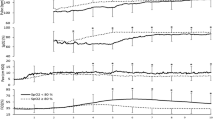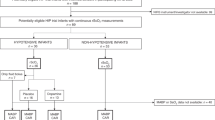Abstract
Objectives:
Examining the effects of tracheal suctioning on cerebral hemodynamics of normotensive ventilated very low birth weight (VLBW) infants with normal cranial ultrasounds; determining the factor(s) influencing changes in mean cerebral blood flow velocity (CBFv) after suctioning.
Methods:
Seventy-three VLBW infants had continuous monitoring of mean arterial blood pressure (MABP), PaCO2, PaO2 and mean CBFv before, during, and after 202 suctioning sessions during the first week of life. Peak (or nadir) and relative changes of the four variables for 45 min after suctioning were calculated. Multiple linear regression was used to determine the factor(s) influencing changes in mean CBFv after suctioning.
Result:
Birth weight was 928±244 g; gestational age was 27.0±2.0 weeks. Mean CBFv increased to 31.0±26.4% after suctioning and remained elevated for 25 min. PaCO2 was highly associated with mean CBFv (P<0.001), whereas MABP and PaO2 were not.
Conclusion:
We observed prolonged increases of mean CBFv following suctioning in ventilated VLBW infants that were previously unrecognized. This is concerning since disturbances of CBF may be associated with subsequent brain injury.
This is a preview of subscription content, access via your institution
Access options
Subscribe to this journal
Receive 12 print issues and online access
$259.00 per year
only $21.58 per issue
Buy this article
- Purchase on Springer Link
- Instant access to full article PDF
Prices may be subject to local taxes which are calculated during checkout


Similar content being viewed by others
References
Perlman JM, Volpe JJ . Suctioning in the preterm infant: Effects on cerebral blood flow velocity, intracranial pressure, and arterial blood pressure. Pediatrics 1983; 72 (3): 329–334.
Simbruner G, Coradello H, Fodor M, Havelec L, Lubec G, Pollak A . Effect of tracheal suction on oxygenation, circulation, and lung mechanics in newborn infants. Arch Dis Child 1981; 56 (5): 326–330.
Fanconi S, Duc G . Intratracheal suctioning in sick preterm infants: prevention of intracranial hypertension and cerebral hypoperfusion by muscle paralysis. Pediatrics 1987; 79 (4): 538–543.
Shah AR, Kurth CD, Gwiazdowski SG, Chance B, Delivoria-Papadopoulos M . Fluctuations in cerebral oxygenation and blood volume during endotracheal suctioning in premature infants. J Pediatr 1992; 120 (5): 769–774.
Burgess GH, Oh W, Brann BS, Brubakk AM, Stonestreet BS . Effects of phenobarbital on cerebral blood flow velocity after endotracheal suctioning in premature neonates. Arch Pediatr Adolesc Med 2001; 155 (6): 723–727.
Durand M, Sangha B, Cabal LA, Hoppenbrouwers T, Hodgman JE . Cardiopulmonary and intracranial pressure changes related to endotracheal suctioning in preterm infants. Crit Care Med 1989; 17: 506–510.
Ninan A, O'Donnell M, Hamilton K, Tan L, Sankaran K . Physiologic changes induced by endotracheal instillation and suctioning in critically ill preterm infants with and without sedation. Am J Perinatol 1986; 3 (2): 94–97.
Kalyn A, Blatz S, Feuerstake S, Paes B, Bautista C . Closed suctioning of intubated neonates maintains better physiologic stability: a randomized trial. J Perinatol 2003; 23: 218–222.
Mosca FA, Colnaghi M, Lattanzio M, Bray M, Pugliese S, Fumagalli M . Closed versus open endotracheal suctioning in preterm infants: effects on cerebral oxygenation and blood volume. Biol Neonate 1997; 72 (1): 9–14.
Kohlhauser C, Bernert G, Hermon M, Popow C, Seidl R, Pollak A . Effects of endotracheal suctioning in high-frequency oscillatory and conventionally ventilated low birth weight neonates on cerebral hemodynamics observed by near infrared spectroscopy (NIRS). Pediatr Pulmonol 2000; 29 (4): 270–275.
Skov L, Ryding J, Pryds O, Greisen G . Changes in cerebral oxygenation and cerebral blood volume during endotracheal suctioning in ventilated neonates. Acta Paediatr 1992; 81 (5): 389–393.
Fisher DM, Frewen T, Swedlow DB . Increase in intracranial pressure during suctioning—stimulation vs rise in Pa. Anesthesiology 1982; 57: 416–417.
van Bel F, van de Bor M, Baan J, Ruys JH . The influence of abnormal blood gases on cerebral blood flow velocity in the preterm newborn. Neuropediatrics 1988; 19 (1): 27–32.
Saliba E, Chantepie A, Autret E, Gold F, Pourcelot L, Laugier J . Effects of indomethacin on cerebral hemodynamics at rest and during endotracheal suctioning in preterm neonates. Acta Paediatr Scand 1991; 80 (6,7): 611–615.
Bernert G, Siebenthal KV, Seidl R, Vanhole C, Devlieger H, Casaer P . The effect of behavioural states on cerebral oxygenation during endotracheal suctioning of preterm babies. Neuropediatrics 1997; 28: 111–115.
Rieger H, Kuhle S, Ipsiroglu OS, Popow CN . Effects of open vs closed system endotracheal suctioning on cerebral blood flow velocities in mechanically ventilated extremely low birth weight infants. J Perinat Med 2005; 33: 435–441.
Milligan DW . Failure of autoregulation and intraventricular hemorrhage in preterm infants. Lancet 1980; 1 (8174): 896–898.
Ment LR, Stewart WB, Duncan CC, Lambrecht R . Beagle puppy model of intraventricular hemorrhage. J Neurosurg 1982; 57: 219–223.
Kaiser JR, Gauss CH, Williams DK . Surfactant administration acutely affects cerebral and systemic hemodynamics and gas exchange in very low birth weight infants. J Pediatr 2004; 144: 809–814.
Gerstmann DR, Minton SD, Stoddard RA, Meredith KS, Monaco F, Bertrand JM et al. The Provo multicenter early high-frequency oscillatory ventilation trial: Improved pulmonary and clinical outcome in respiratory distress syndrome. Pediatrics 1996; 98 (6): 1044–1057.
Moriette G, Paris-Llado J, Walti H, Escande B, Magny JF, Cambonie G et al. Prospective randomized multicenter comparison of high-frequency oscillatory ventilation and conventional ventilation in preterm infants of less than 30 weeks with respiratory distress syndrome. Pediatrics 2001; 107 (2): 363–372.
Mariani G, Cifuentes J, Carlo WA . Randomized trial of permissive hypercapnia in preterm infants. Pediatrics 1999; 104 (5): 1082–1088.
Medicine AioUi. Bioeffects and Safety of Diagnostic Ultrasound. American Institute of Ultrasound in Medicine: Laurel, 1993.
Neter J, Kutner M, Nachtsheim C, Wasserman W . Applied Linear Statistical Models. 4th edn WCB/McGraw-Hill: Boston, 1996.
Tyszczuk L, Meek J, Elwell C, Wyatt JS . Cerebral blood flow is independent of mean arterial blood pressure in preterm infants undergoing intensive care. Pediatrics 1998; 102 (2): 337–341.
Wyatt JS, Edwards AD, Cope M, Delpy DT, McCormick DC, Potter A et al. Response of cerebral blood volume to changes in arterial carbon dioxide tension in preterm and term infants. Pediatr Res 1991; 29 (6): 553–557.
Pryds O, Greisen G . Effect of PaCO2 and haemoglobin concentration on day to day variation of CBF in preterm neonates. Acta Paediatr Scand Suppl 1989; 360: 33–36.
Leahy FAN, Cates D, MacCallum M, Rigatto H . Effect of CO2 and 100% O2 on cerebral blood flow in preterm infants. J Appl Physiol 1980; 48: 468–472.
Lou HC, Lassen NA, Friis-Hansen B . Impaired autoregulation of cerebral blood flow in the distressed newborn infant. J Pediatr 1979; 94 (1): 118–121.
Bode H, Wais U . Age dependence of flow velocities in basal cerebral arteries. Arch Dis Child 1988; 63: 606–611.
Romagnoli C, Giannantonio C, De Carolis MP, Gallini F, Zecca E, Papacci P . Neonatal color Doppler US study: normal values of cerebral blood flow velocities in preterm infants in the first month of life. Ultrasound Med Biol 2006; 32 (3): 321–331.
Gressens P, Rogido M, Paindaveine B, Sola A . The impact of neonatal intensive care practices on the developing brain. J Pediatr 2002; 140 (6): 646–653.
Tsuji M, Saul JP, du Plessis A, Eichenwald E, Sobh J, Crocker R et al. Cerebral intravascular oxygenation correlates with mean arterial pressure in critically ill premature infants. Pediatrics 2000; 106: 625–632.
Niijima S, Shortland DB, Levene MI, Evans DH . Transient hyperoxia and cerebral blood flow velocity in infants born prematurely and at full term. Arch Dis Child 1988; 63: 1126–1130.
Greisen G, Johansen K, Ellison PH, Fredriksen PS, Mali J, Friis-Hansen B . Cerebral blood flow in the newborn infant: comparison of Doppler ultrasound and 133xenon clearance. J Pediatr 1984; 104 (3): 411–418.
Acknowledgements
The technical assistance of Natalie C Sikes and Melanie Mason, and the support of the University of Arkansas for Medical Sciences neonatologists, NICU nurses, respiratory therapists and ultrasound technicians, are gratefully acknowledged. JR Kaiser was supported by a National Institute of Neurological Disorders and Stroke Grant 1 K23 NS43185. The University of Arkansas for Medical Sciences, Center for Translational Neuroscience (RR20146) and General Clinical Research Center (M01RR14288) also supported this study. This study was presented, in part, at the 2006 Pediatric Academic Society, Society for Pediatric Research meeting, San Francisco, CA, April 29-May 2, 2006. There are no potential, perceived, or real conflicts of interest.
Author information
Authors and Affiliations
Corresponding author
Rights and permissions
About this article
Cite this article
Kaiser, J., Gauss, C. & Williams, D. Tracheal suctioning is associated with prolonged disturbances of cerebral hemodynamics in very low birth weight infants. J Perinatol 28, 34–41 (2008). https://doi.org/10.1038/sj.jp.7211848
Received:
Revised:
Accepted:
Published:
Issue Date:
DOI: https://doi.org/10.1038/sj.jp.7211848
Keywords
This article is cited by
-
Neonatal cerebrovascular autoregulation
Pediatric Research (2018)
-
Ontogeny of cerebrovascular critical closing pressure
Pediatric Research (2015)
-
The ontogeny of cerebrovascular pressure autoregulation in premature infants
Journal of Perinatology (2014)
-
Observational study of cerebral hemodynamics during dopamine treatment in hypotensive ELBW infants on the first day of life
Journal of Perinatology (2013)
-
The effects of closed tracheal suctioning plus volume guarantee on cerebral hemodynamics
Journal of Perinatology (2011)



